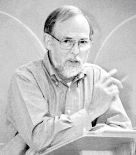David Lindberg is Hilldale Professor Emeritus of the History of Science at the University of Wisconsin holds the M.S. degree in physics from Northwestern University and a Ph.D. in history and philosophy of science from Indiana University. He has written or edited thirteen books and is now editing (with Ronald Numbers) the forthcoming 8-volume Cambridge History of Science. He is a Fellow of the Medieval Academy of America, the Académie internationale d’histoire des sciences, and the American Academy of Arts and Sciences. He has been a visiting member of the Institute for Advanced Study in Princeton and the Bellagio Study Center of the Rockefeller Foundation, as well as a Guggenheim Fellow. He was President of the History of Science Society in 1994-1995 and, in 1999, received the Sarton Medal of the History of Science Society for lifetime scholarly achievement. His book, The Beginnings of Western Science, was awarded the 1994 Watson Davis Prize of the History of Science Society and the 1995 John Templeton Foundation Prize for Outstanding Books in Theology and Natural Science.
Prof. Lindberg’s non science-religion research has been primarily in medieval and early modern mathematical science, especially geometrical optics and theories of vision. In addition to his work as co-editor of The Cambridge History of Science, of which three volumes have been published to date, he is revising Beginnings of Western Science and planning a short history of science for non-specialist readers.
Science-religion publications include
- When Science and Christianity Meet, ed. David C. Lindberg and Ronald L. Numbers, Chicago: University of Chicago Press (2003), 357 pp.
- The Beginnings of Western Science: The European Scientific Tradition in Philosophical, Religious, and Institutional Context, 600 B.C. – A.D. 1450, Chicago: University of Chicago Press (1992),455 pp.
- God and Nature:Historical Essays on the Encounter between Christianity and Science, ed. Lindberg and Numbers,Berkeley and Los Angeles:University of California Press (1986).
- ‘Early Christian Attitudes Toward Nature’, in Science and Religion: A Historical Introduction, ed. Gary B. Ferngren, Baltimore: Johns Hopkins University Press (2002), pp. 47-56.
- ‘Medieval Science and Christianity’, in Science and Religion: A Historical Introduction, ed. Gary B. Ferngren, Baltimore: Johns Hopkins University Press (2002), pp. 57-72.
- ‘Medieval Science and Its Religious Context’, in Constructing Knowledge in the History of Science, ed. Arnold Thackray, which appeared as Osiris, 10 (1995), 60-79.
- ‘Science as Handmaiden: Roger Bacon and the Patristic Tradition’, Isis, 78 (1987), 518-36.
- ‘Beyond War and Peace: A Reappraisal of the Encounter between Christianity and Science’ (with Ronald L. Numbers), Church History, 55 (l986), 338-54.
- ‘Science and the Early Christian Church’, Isis, 74 (1983), pp.509-30
Other publications incude
- Roger Bacon and the Origins of Perspectiva in the Middle Ages: A Critical Edition and English Translation of Bacon’s Perspectiva with Introduction and Notes, Oxford: Clarendon Press (1996), 524 pp.
- The Beginnings of Western Science: The European Scientific Tradition in Philosophical, Religious, and Institutional Context, 600 B.C – A.D 1450, Chicago: University of Chicago Press (1992), 473 pp.
- Roger Bacon’s Philosophy of Nature: A Critical Edition, with English Translation, Introduction, and Notes, of De multiplicatione specierum and De speculis comburentibus, Oxford:Clarendon Press (1983),502 pp.
- Studies in the History of Medieval Optics, London:Variorum Reprints (1983),302 pp.
- Theories of Vision from al-Kindi to Kepler, Chicago:University of Chicago Press (1976),336 pp.
- A Catalogue of Medieval and Renaissance Optical Manuscripts,Toronto:Pontifical Institute of Mediaeval Studies (1975),142 pp.




